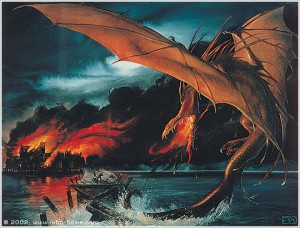
A lot of folks have — in the wake of the trailers for The Desolation of Smaug — been pondering the question about the number of legs our favourite big, bad beastie might possess in the estimation of Peter Jackson (and his conceptual artists Alan Lee and John Howe).
Four? Two? It seems to be a bit unclear.
Here, Ringer Arandir examines the evidence (he does say that it’s not movie spoilery, but I think it is a little bit, so here’s your warning) and posits that we may be seeing a mid-stream change in Smaug’s conceptual design.
Dragons vs Wyverns: The Question of Smaug
I love dragons. They’re simply the most fascinating creatures in any mythology or fantasy story – capable of breathing fire and roaming the skies (among other things). Modern-day narratives seem to place these beings on the good side, and whilst still intriguing, I rather prefer the good-old evil and nasty creatures from European literature.
Nothing beats the wickedness of Fáfnir from the Volsunga Saga; nor the gold-hoarding dragon from Beowulf; not to mention Tolkien’s own array of scaly beasts; mainly from ‘The Silmarillion’ and ‘The Hobbit’.
So why this post?
A couple of things come to mind as to the reason for this slightly complex, but highly fascinating (to me) discussion.
I’ve just acquired (and seen) the Extended Edition to ‘An Unexpected Journey’ (to which I’ll be adding a review very soon) and noticed something particular about Smaug’s design.
My suspicions first arose when the second trailer of ‘The Desolation of Smaug’ was released in October, noticing that the last shot of Smaug throwing fire to the screen had no forelegs – unlike what we had clearly seen in the prologue to ‘An Unexpected Journey’.
But first let’s give a quick introduction to the technical terms in dragonology…
“Dragons” and “Wyverns”
At first glance, they look exactly the same. Even I, up to a couple of weeks ago, thought that the two creatures were basically the same – thinking that the two words were simply describing the same being.
But I was wrong, to my glad surprise.
Wyverns are (or were) described in Medieval literature as being these serpent-like creatures with wings, often having spiked tails and mainly used in heraldic emblems
Pretty similar, right? The catch?
Unlike dragons, wyverns often have only two hind legs – using claws attached to their wings to make their way on ground.
Apart from a whole lot of differences currently not relevant to the scope of this article, you need only keep in mind that dragons have four legs in total – whilst wyverns have only two.


